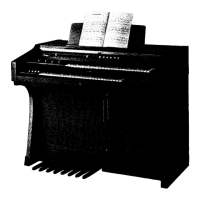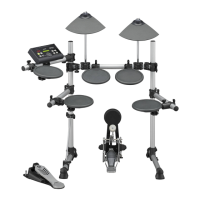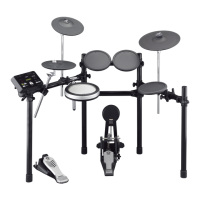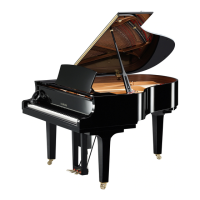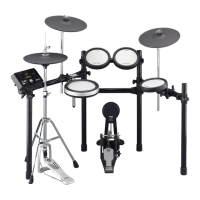Do you have a question about the Yamaha D-85 and is the answer not in the manual?
Guidance on power voltage, servicing, and proper cleaning methods.
Advice on proper usage, placement, and avoiding physical damage or chemical reactions.
Information on the number of keys, octaves, and layout for each keyboard.
Description of the pedal keys and their function.
Explains how note priority is determined on specific keyboards.
Steps for connecting power, turning on, and setting volume.
Instructions for selecting a sound and testing the expression pedal.
Advice on what to do if no sound is heard.
Explains the musical intervals indicated by footage numbers on tone levers.
Guidance on combining levers for richer expression and tone colors.
Details how combining levers creates multiple notes from a single key.
How to select and combine tone colors for the upper and lower keyboards.
Selecting tone colors for the pedal keyboard.
Adjusting the volume balance between upper and lower keyboards.
Using vibrato, wah effects, and their associated delay, depth, and speed controls.
Controlling sound brilliance and adjusting the decay time of attack sounds.
Listing and description of the 12 available tone colors for the solo keyboard.
Explanation of the solo keyboard's monophonic playing characteristic.
How to adjust pitch and introduce note-to-note transitions.
Adjusting musical interval range and tone color mellow/brilliant.
Using vibrato, wah, and touch-sensitive effects on the solo keyboard.
How to set and use special preset tone colors on the upper keyboard.
Combining preset tones and custom voices with ensemble settings.
How the Symphonic button enhances preset sounds with ambience.
Enabling special presets to be played on the lower keyboard.
Combining special preset sounds with standard tone lever sounds.
Adjusting the volume of special preset tones.
How to choose and play single custom voice tone colors.
Applying the Symphonic Chorus effect to custom voice sounds.
Methods for producing custom voice sounds on upper or lower keyboards.
Using the BRIGHT control to alter the tone color to be mellow or brilliant.
Techniques for playing custom voices and combining them with other tone levers.
Choosing rhythm patterns and adding variations for musical expression.
Using break variations for accents and adjusting rhythm volume/balance.
Using START and SYNC start switches to control rhythm initiation.
Adjusting tempo with the control and using break variation buttons.
Displaying tempo speed and current bar and beat during rhythm playback.
Interpreting memory full and program end indicators on the display.
Overview of programmer buttons and memory capacity for rhythms.
Step-by-step guide to recording rhythms, variations, and break variations.
Procedures for correcting errors during rhythm programming.
Techniques for continuous playback of stored rhythm programs.
How to check stored programs and change existing rhythm sequences.
Adjusting tone controls for rhythmic chord sounds.
How automatic accompaniment works with rhythms and keyboard input.
Using the Single Finger Chord button for automatic accompaniment.
Understanding chord types and using the MEMORY function for continuous accompaniment.
How to create accompaniment by striking chords on the lower keyboard.
Using the CUSTOM A-B-C function for lower keyboard and pedal keyboard.
Selecting different bass patterns and controlling Auto Bass/Chord start/stop.
Selecting arpeggio patterns and adjusting voice controls for effects.
Using auto arpeggio with auto bass/chord functions.
How rhythm patterns affect auto arpeggio note sequencing.
How tremolo affects volume variation and its speed control.
Using Symphonic Chorus to create a massed sound effect.
Adjusting the speed of the tremolo effect.
Mixing solo keyboard sounds with upper or pedal keyboards.
Using foot switches for glide and upper damper effects.
Applying reverberation and controlling note sustain duration.
Stopping rhythms with a foot switch and enabling solo portamento.
Using reverb effect and adjusting flute and orchestra tone responses.
Using sustain controls for upper and lower keyboard tone colors.
Adding sustain to pedal sounds and applying percussive decay.
Addressing noise, reception degradation, and sound fluctuations.
Resolving issues with note sound priority and handling vibration.
Troubleshooting problems with Auto Bass/Chord activation and interval changes.
Addressing sound resonance and perceived pitch differences.
Key count, ranges, and tone lever types for each section.
Specifications for effects, rhythm functions, and programmers.
Details on speaker output, power consumption, and dimensions.
Details on rhythmic chord and auto arpeggio section functions and controls.
Specifications for foot switches, expression pedal, and other controls.
Specifications for audio system, physical dimensions, and wiring codes.
Specifications for solo keyboard, modulation selectors, and general controls.
Details on amplification system, electrical data, and British-Standard wiring.
| Keys | 88 |
|---|---|
| Voices | 10 |
| Type | Digital Piano |
| Effects | Reverb, Chorus |
| Built-in Songs | 10 demo songs |
| Connections | MIDI In/Out |



